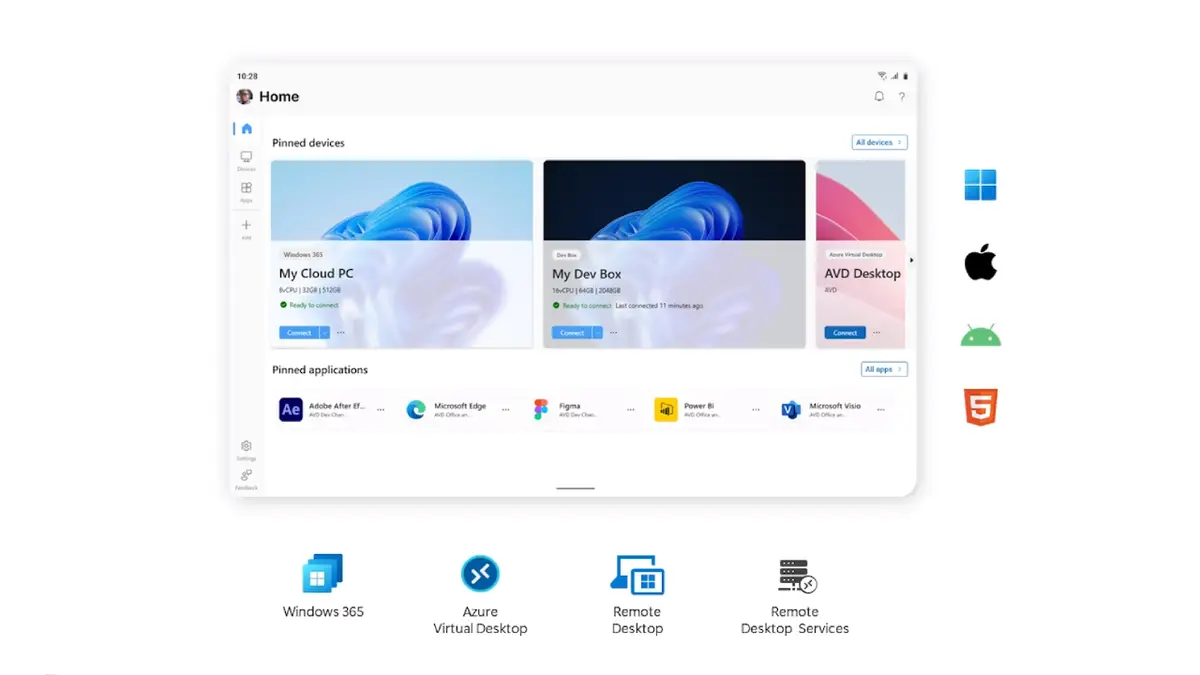“Microsoft Retires Legacy Remote Desktop App in May – Transition to Modern Solutions Now.”
How The Remote Desktop App Discontinuation Impacts Users And Next Steps

Microsoft’s announcement that it will discontinue the Remote Desktop app (commonly known as the Microsoft Store version) in May marks a significant shift for users reliant on this tool for remote access to Windows devices and virtual desktops. The decision to phase out the legacy app reflects Microsoft’s broader strategy to streamline its remote connectivity solutions under the newer Windows Remote Desktop client, which has been available for several years. While the change aims to consolidate features and enhance user experience, it raises immediate questions for individuals, IT administrators, and organizations about continuity, migration, and adaptation.
The discontinuation primarily impacts users who depend on the Microsoft Store version of the Remote Desktop app for its simplicity and integration with Windows ecosystems. After May, the app will no longer receive updates or technical support, leaving existing installations functional but increasingly vulnerable to security risks and compatibility issues as Windows evolves. Notably, this does not affect the built-in Remote Desktop Protocol (RDP) capabilities in Windows Pro and Enterprise editions, nor does it apply to third-party remote desktop tools. However, for those who prefer the Microsoft Store app’s interface, the shift necessitates a transition to the updated Windows Remote Desktop client, which offers a similar but more modernized experience.
Key differences between the legacy app and the new client underscore why Microsoft is pushing for migration. The newer version supports advanced features like Dynamic Display Resolution, which automatically adjusts screen sizes across devices, and multi-monitor configurations for seamless productivity. It also integrates more tightly with Microsoft’s cloud services, including Azure Virtual Desktop and Microsoft Endpoint Manager, making it a stronger fit for hybrid work environments. Furthermore, the updated client emphasizes security improvements, such as Network Level Authentication (NLA) and compatibility with Windows Hello for biometric sign-ins, addressing growing concerns about remote access vulnerabilities.
For users navigating this transition, several steps are critical. First, download the Windows Remote Desktop client directly from Microsoft’s website or the Microsoft Store, ensuring compatibility with your operating system. Next, migrate existing connection configurations by exporting settings from the legacy app and importing them into the new client—a process Microsoft has simplified to minimize downtime. Organizations should also audit their remote access workflows to identify any dependencies on the older app, update training materials, and communicate the change to employees to avoid confusion. IT teams must verify that firewalls and network policies accommodate the new client’s requirements, particularly if cloud integrations are in use.
While the transition is largely straightforward, potential challenges include compatibility hiccups with older systems and minor interface adjustments for users accustomed to the legacy app. Microsoft’s documentation and support forums provide guidance for troubleshooting, but proactive planning remains essential. Backup critical remote connection profiles before migration, and consider testing the new client in a controlled environment before full deployment.
Ultimately, Microsoft’s move aligns with its vision of a unified, cloud-centric remote access framework. By retiring the standalone Remote Desktop app, the company reinforces its commitment to scalable, secure solutions tailored to modern work dynamics. For users, this transition is an opportunity to embrace enhanced capabilities while future-proofing their remote access strategies. As May approaches, prioritizing these steps will ensure seamless continuity and leverage the full potential of Microsoft’s evolving remote connectivity ecosystem.
Key Reasons Behind Microsoft’s Decision To Retire The Remote Desktop App
Microsoft’s announcement to phase out its standalone Remote Desktop app by May marks a strategic shift in the company’s approach to remote access solutions. While the decision has sparked discussions among users reliant on the tool, it reflects a broader effort to align with evolving technological demands and prioritize integrated cloud-based services. Understanding the rationale behind this move requires examining multiple factors, from Microsoft’s product consolidation strategy to the imperative of modernizing security and user experience.
A primary driver of this decision is Microsoft’s focus on streamlining its portfolio. Over recent years, the company has invested heavily in Azure Virtual Desktop and Windows 365, cloud-centric platforms designed to offer seamless remote access while integrating with its broader ecosystem. By retiring the standalone app, Microsoft aims to redirect users toward these solutions, which provide enhanced scalability, centralized management, and compatibility with hybrid work environments. This consolidation reduces redundancy, ensuring customers leverage tools built with current IT infrastructure and workforce needs in mind.
Security considerations also play a pivotal role. The legacy Remote Desktop app, while functional, lacks the advanced safeguards embedded in newer platforms. As cyber threats grow more sophisticated, Microsoft emphasizes the need for solutions that incorporate zero-trust principles, multi-factor authentication, and end-to-end encryption—features more robustly supported in Azure Virtual Desktop. Migrating users to modern services allows the company to mitigate risks associated with outdated software, aligning with its commitment to proactive threat management.
Technological advancement further underscores this transition. The traditional app’s architecture, designed for on-premises use, struggles to meet the scalability and flexibility demands of today’s cloud-driven world. Modern remote work requires tools that support cross-platform access, real-time collaboration, and elastic resource allocation—capabilities inherent in Azure-based solutions. Retiring the older app ensures users adopt platforms optimized for current workflows, reducing compatibility issues with newer operating systems like Windows 11 and fostering innovation.
User experience improvements also factor into the decision. Fragmented tools can lead to inconsistent performance and increased complexity. By unifying remote access under integrated platforms, Microsoft simplifies IT administration and enhances end-user productivity. Features such as automated updates, AI-driven troubleshooting, and seamless integration with Microsoft 365 apps create a cohesive environment, reducing downtime and streamlining operations.
Finally, maintaining legacy software incurs significant costs. Allocating resources to outdated tools diverts investments from cutting-edge technologies. Retiring the app allows Microsoft to focus on advancing its cloud offerings, ensuring long-term sustainability and responsiveness to market trends.
In conclusion, Microsoft’s decision to phase out the Remote Desktop app stems from a strategic realignment toward scalable, secure, and user-centric cloud solutions. While the transition may require adjustments, it underscores the company’s commitment to innovation and operational efficiency. Users are encouraged to explore Azure Virtual Desktop and Windows 365, which not only address current remote access needs but also position organizations to thrive in an increasingly digital future. As May approaches, Microsoft’s support and migration guidance will be pivotal in ensuring a smooth evolution for its global user base.
Alternatives To Microsoft’s Remote Desktop App After May Phase-Out
Microsoft has announced that it will phase out its Remote Desktop app in May, marking the end of an era for a tool long relied upon by businesses and individuals for remote access. This decision leaves many users seeking alternatives that offer comparable functionality, security, and ease of use. Fortunately, the market is rich with robust solutions designed to meet diverse needs, from enterprise-level operations to personal use. As organizations and individuals prepare for this transition, several options stand out for their reliability, cross-platform compatibility, and advanced features.
One notable alternative is TeamViewer, a widely recognized platform praised for its versatility and user-friendly interface. Supporting Windows, macOS, Linux, iOS, and Android, TeamViewer enables seamless remote control, file transfers, and multi-monitor navigation. Its strong encryption protocols and two-factor authentication (2FA) make it a secure choice for sensitive operations. While the free version caters to personal use, commercial licenses provide additional features such as session recording and mass deployment tools, making it scalable for businesses of all sizes.
Another popular choice is AnyDesk, which emphasizes low latency and high-speed connections—ideal for tasks requiring real-time interaction, such as IT support or creative collaboration. Compatible with major operating systems and lightweight in design, AnyDesk offers features like clipboard synchronization and session logging. Its modular pricing structure allows users to pay only for the functionalities they need, balancing cost and performance. For organizations prioritizing speed without compromising security, AnyDesk’s TLS 1.2 encryption and customizable access controls present a compelling option.
Google’s Chrome Remote Desktop provides a straightforward, browser-based solution for users embedded in the Google ecosystem. Accessible via Chrome browsers or dedicated mobile apps, this free tool simplifies remote connections without requiring complex setups. While it lacks advanced features like session analytics, its simplicity and integration with Google Accounts appeal to casual users and small teams. However, enterprises may find its limited administrative tools insufficient for large-scale deployments, making it better suited for personal or occasional use.
Splashtop strikes a balance between affordability and functionality, particularly for business and educational institutions. Known for its high-definition performance and low latency, Splashtop supports remote access across devices, including cross-platform connections between Windows and macOS. Features like remote wake-on-LAN and bulk deployment enhance its utility for IT departments. Subscription tiers vary from individual plans to enterprise packages, offering flexibility based on organizational needs. Its emphasis on cost-effectiveness positions it as a practical alternative for budget-conscious users unwilling to sacrifice performance.
For those prioritizing open-source solutions, Apache Guacamole offers a unique, browser-based approach without requiring client installations. This self-hosted platform allows access to remote machines via a web interface, supporting standard protocols like RDP, VNC, and SSH. While setup demands technical expertise, Guacamole’s customization potential and centralized access management appeal to tech-savvy users and organizations with stringent data control requirements. Its community-driven development ensures continuous updates and transparency, though enterprises may need dedicated IT resources for maintenance.
Other contenders include LogMeIn, RemotePC, and ConnectWise Control, each offering distinct advantages such as cloud storage integration or specialized IT support tools. When evaluating alternatives, key considerations include end-to-end encryption, cross-platform support, scalability, and compliance with industry standards like GDPR or HIPAA. Performance factors such as latency and bandwidth efficiency also play a critical role, particularly for industries reliant on real-time data access.
As the May phase-out approaches, users are encouraged to
